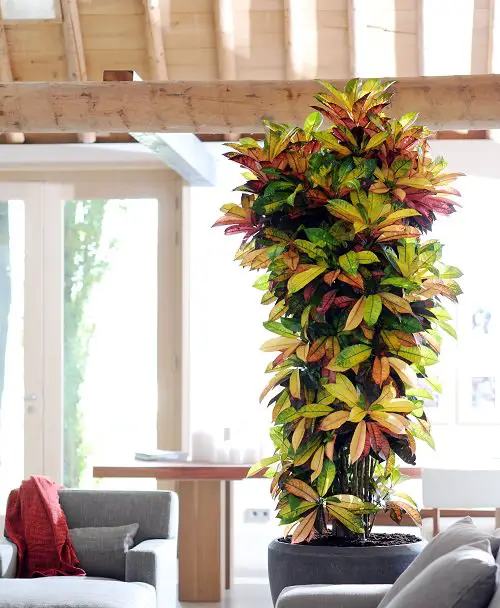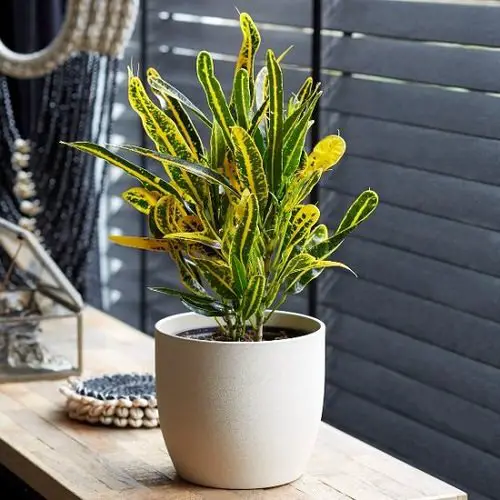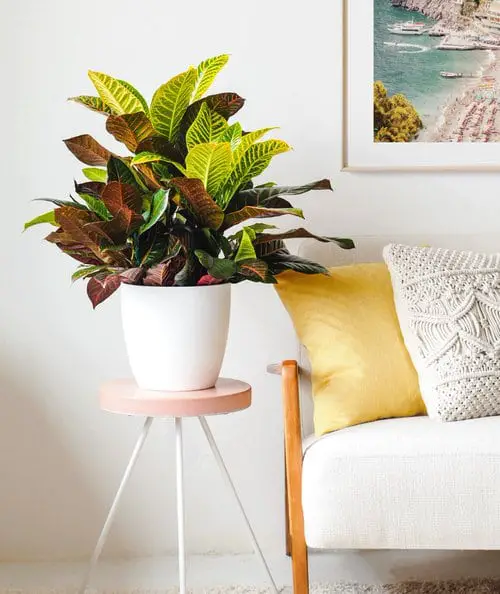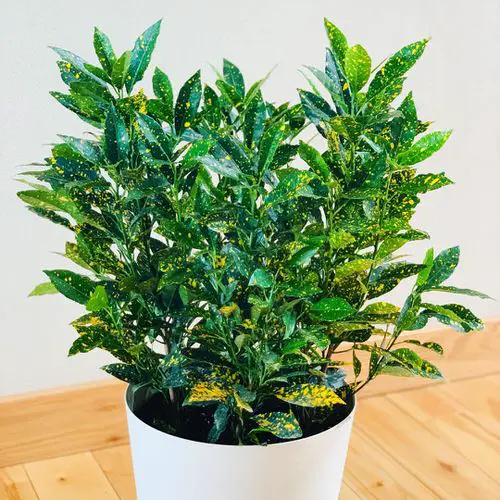Vibrant colors and ease of maintenence are what make croton a great houseplant. Know everything about Croton Plant Care Indoors and more!

The croton’s bright colors can draw just the right amount of attention to any space it occupies. Though it has quite the reputation of being a fussy plant, in reality, Croton Plant Care Indoors, if done correctly, can make it one of the most resilient and hard-to-kill plants.
Have a look at the different types of Crotons you can grow here
About Croton
The tropical plant has leathery, thick leaves of differing shapes, shadings, and sizes. With age, the plant’s tone may turn darker. It can generally grow up to 8-10 feet in height; however, it remains a lot more modest when grown as a houseplant.
Kindly note that houseplant is poisonous if ingested. Croton can give out a smooth sap that can make stains and bother the skin.
Best Varieties of Croton to Grow Indoors

- Gold Star: It has green leaves splashed with the brightest’ stars’ in a gold-tone that can instantly add warmth to your home.
- Petra: A popular cultivar with deep green leaves and veins in orange, auburn, scarlet, yellow, lemon colors are also known for its stunning bushy foliage.
- Eleanor Roosevelt: Another popular cultivar with slender leaves in shades of lime green to burgundy dotted with bright yellow gives an impression of spray painted.
- Oakleaf: As the name suggests, it has oak leaf-shaped bronze-colored or dark green leaves with yellow, red, and orange veins.
Propagating Croton
It is best done with stem cuttings.
- Take 6-8 inches of cutting from an actively growing branch by cutting at a 45-degree angle, just above a node. Remove all the bottom leaves, keeping the top ones intact.
- Dip the end in a rooting hormone and plant it in a pot filled with a quality potting mix. Water well and cover the cutting with a plastic bag. Place the container in a warm place at 60-80 F or 15-26 C.
- With suitable soil, temperature, water, and light conditions, the plant will grow roots in 25-30 days. You can transplant it into a larger container.
- Once the plant reaches maturity, the foliage will grow brighter and colorful.
Requirements for Growing Croton Indoors

Right Location
Crotons prefer several hours of direct sunlight but can also tolerate being in full day bright indirect light too. Light exposure is directly linked to the intensity of the color of the foliage. So, to achieve full, vibrant color, the plant should be placed in a bright spot that receives a combination of direct and indirect daylight. A south-facing window would be an ideal spot!
Right Soil
The tropical evergreen prefers well-drained soil with lots of organic matter. Any good quality potting mix designed for an indoor plant would aid in its growth well. You can also use organic compost and peat moss in equal quantities.
Watering
This tropical plant favors a humid environment, and the soil should always remain evenly moist but not soggy. Keep an eye on the topsoil and water the plant when it feels dry to touch.
Tip: Use the new croton foliage as your indicator of the water needs. You will notice the wilting of leaves when the plant feels thirsty.
Right Temperature
Native to tropical forests of Asia and Oceania, crotons like warmer climates, and if temperatures drop below 50-55 F or 10-12 C, the leaves start to fade and may turn brown gradually.
The ideal indoor temperature for the plant’s excellent growth is around 60-86 F or 15-30 C.
Croton Plant Care Indoors
Fertilizer
A liquid-balanced feed like 10-10-10 will give it all the boost the plant needs. Apply it once in 4 weeks for best results. Do follow the instructions on the label or if you want to fertilize more frequently, fertilize in weak strength.
Humidity
If your indoor air is very dry, consider placing the plant on a peddle tray to retain the right humidity levels. You can also use the humidifier.
Pests and Diseases
Usually, crotons do not have much trouble with diseases or pests. However, they can fall prey to common houseplant pests like aphids, mealybugs, scale insects, thrips, or spider mites.
You can get rid of these by removing them by hand. Use a cotton swab or ball dipped in rubbing alcohol or vinegar to clean them away.
Pruning
Croton needs trimming when it starts to grow leggier and light pruning to get rid of the dead leaves.
For a denser, bushier look, cut back the plant to a point from where you would want the plant to start growing much thicker foliage. Spring is the best time to prune the plant. Avoid cutting the foliage in winters.
Croton Plant Winter Care

Crotons grow best in warmer weather, which means they can hardly tolerate hard frost at all. Indoors, place your croton in a bright spot near a window that receives at least 5-6 hours of daylight every day. You may also use a humidifier to maintain the humidity levels for the plant during winters.


